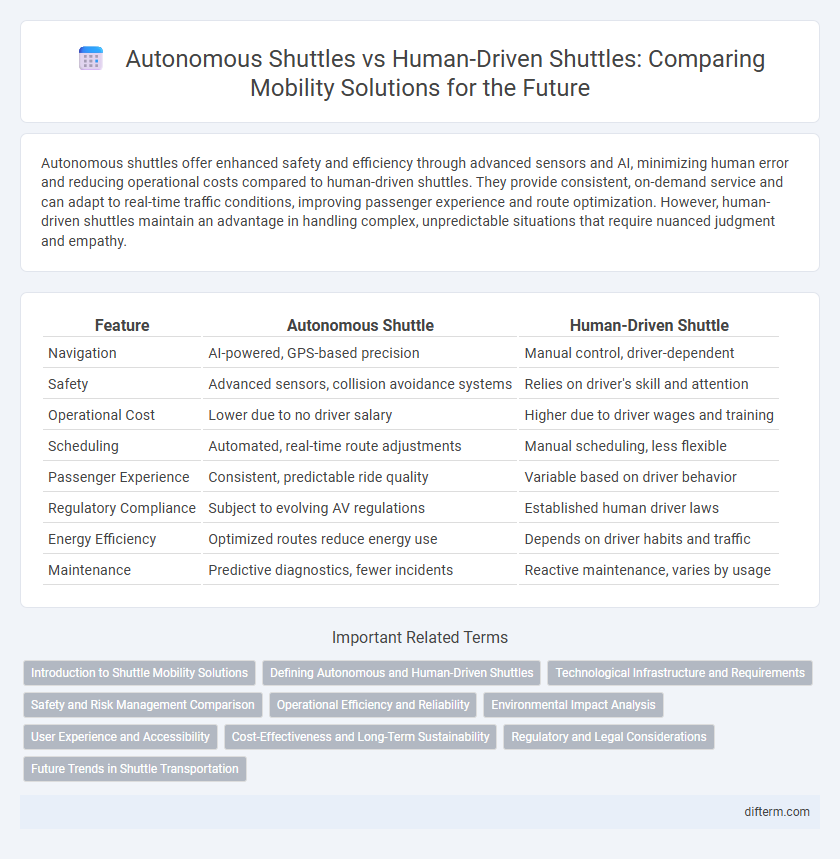Autonomous shuttles offer enhanced safety and efficiency through advanced sensors and AI, minimizing human error and reducing operational costs compared to human-driven shuttles. They provide consistent, on-demand service and can adapt to real-time traffic conditions, improving passenger experience and route optimization. However, human-driven shuttles maintain an advantage in handling complex, unpredictable situations that require nuanced judgment and empathy.
Table of Comparison
| Feature | Autonomous Shuttle | Human-Driven Shuttle |
|---|---|---|
| Navigation | AI-powered, GPS-based precision | Manual control, driver-dependent |
| Safety | Advanced sensors, collision avoidance systems | Relies on driver's skill and attention |
| Operational Cost | Lower due to no driver salary | Higher due to driver wages and training |
| Scheduling | Automated, real-time route adjustments | Manual scheduling, less flexible |
| Passenger Experience | Consistent, predictable ride quality | Variable based on driver behavior |
| Regulatory Compliance | Subject to evolving AV regulations | Established human driver laws |
| Energy Efficiency | Optimized routes reduce energy use | Depends on driver habits and traffic |
| Maintenance | Predictive diagnostics, fewer incidents | Reactive maintenance, varies by usage |
Introduction to Shuttle Mobility Solutions
Autonomous shuttles leverage advanced sensors, AI, and real-time data processing to navigate complex urban environments with enhanced safety and efficiency. Human-driven shuttles rely on skilled operators but face limitations in consistency and operational costs. Integrating autonomous shuttle technology into mobility solutions reduces traffic congestion, lowers emissions, and improves accessibility in public transportation networks.
Defining Autonomous and Human-Driven Shuttles
Autonomous shuttles utilize advanced sensor fusion, artificial intelligence, and real-time data processing to navigate complex urban environments without human intervention. Human-driven shuttles rely on a human operator to control the vehicle, ensuring responsiveness to dynamic traffic and pedestrian situations. Defining these shuttles highlights the shift towards machine learning algorithms and vehicle-to-everything (V2X) communication in autonomous systems compared to traditional manual driving techniques.
Technological Infrastructure and Requirements
Autonomous shuttles require advanced sensor arrays, including LiDAR, radar, and cameras, integrated with high-precision GPS and real-time data processing systems to ensure safe navigation and obstacle detection. Human-driven shuttles primarily depend on conventional vehicle mechanics and minimal digital infrastructure, relying on driver skills and existing road networks without the need for complex AI or V2X communication systems. The deployment of autonomous shuttles necessitates robust networking infrastructure to support vehicle-to-infrastructure (V2I) and vehicle-to-vehicle (V2V) communication, enabling coordinated movement and enhancing overall transit efficiency.
Safety and Risk Management Comparison
Autonomous shuttles leverage advanced sensors, real-time data processing, and machine learning algorithms to reduce human error, resulting in enhanced safety and lower accident rates compared to human-driven shuttles. Human-driven shuttles are subject to variability in driver attention, fatigue, and decision-making, increasing the risk of collisions and operational errors. Risk management in autonomous shuttles includes continuous system diagnostics and fail-safe mechanisms, whereas human-driven shuttles rely heavily on driver training and compliance with safety protocols.
Operational Efficiency and Reliability
Autonomous shuttles enhance operational efficiency by utilizing advanced sensors and AI algorithms to optimize routes, reduce idle times, and adapt to real-time traffic conditions, resulting in consistent and predictable service. Human-driven shuttles, while flexible in complex environments, exhibit variability due to driver fatigue and decision-making disparities, which can lead to increased operational costs and downtime. The reliability of autonomous shuttles is bolstered by continuous system monitoring and diagnostics, minimizing unexpected failures compared to the human factor-dependent reliability of traditional shuttles.
Environmental Impact Analysis
Autonomous shuttles reduce greenhouse gas emissions by optimizing routes and utilizing electric powertrains, resulting in lower carbon footprints compared to human-driven shuttles that often rely on fossil fuels. Energy consumption decreases through consistent driving patterns enabled by autonomous systems, minimizing acceleration and braking inefficiencies common in human operators. Lifecycle assessments indicate that autonomous shuttles contribute significantly to urban air quality improvement by reducing pollutants and noise pollution.
User Experience and Accessibility
Autonomous shuttles enhance user experience by offering consistent, smooth rides with real-time route adjustments based on passenger data, improving accessibility for individuals with disabilities through customizable boarding assistance and voice-activated controls. Human-driven shuttles provide personalized interaction and adaptive decision-making in complex environments but may introduce variability in service quality and accessibility features. Advances in sensor technology and AI in autonomous shuttles are bridging gaps in safety and inclusivity, positioning them as scalable solutions for urban mobility challenges.
Cost-Effectiveness and Long-Term Sustainability
Autonomous shuttles reduce operational costs by eliminating driver salaries and enabling efficient energy use through electric propulsion, resulting in significant savings over traditional human-driven shuttles. Maintenance expenses also decline due to advanced predictive monitoring systems that prevent costly breakdowns and extend vehicle lifespan. Over time, autonomous shuttles contribute to sustainable urban mobility by lowering carbon emissions and minimizing traffic congestion through optimized routing and consistent driving patterns.
Regulatory and Legal Considerations
Autonomous shuttles face evolving regulatory frameworks requiring compliance with stringent safety standards, data privacy laws, and real-time operational monitoring compared to human-driven shuttles, which operate under established traffic regulations and liability norms. Liability in autonomous shuttle incidents often shifts toward manufacturers and software developers, raising complex legal challenges absent in human-driven shuttle cases where driver fault is typically assessed. Regulatory bodies worldwide are actively developing certification processes and operational guidelines to ensure safe integration of autonomous shuttles into public roadways, emphasizing cybersecurity and fail-safe mechanisms.
Future Trends in Shuttle Transportation
Autonomous shuttles are revolutionizing future trends in shuttle transportation by enhancing safety through advanced sensor technology and reducing operational costs via automation. Human-driven shuttles, while currently dominant, face challenges such as higher labor expenses and inconsistent driving behavior. Integration of AI and V2X communication systems positions autonomous shuttles as key components of smart city mobility solutions.
autonomous shuttle vs human-driven shuttle Infographic

 difterm.com
difterm.com